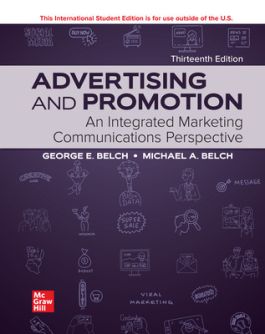Advertising and Promotion ISE
Chapter 1: An Introduction to Integrated Marketing Communications
Chapter 2: The Role of IMC in the Marketing Process?
PART TWO: INTEGRATED MARKETING COMMUNICATIONS PROGRAM SITUATION ANALYSIS
Chapter 3: Organizing for Advertising and Promotion: The Role of Ad Agencies and Other Marketing Communication Organizations
Chapter 4: Perspectives on Consumer Behavior
PART THREE: ANALYZING THE COMMUNICATION PROCESS
Chapter 5: The Communication Process?
Chapter 6: Source, Message, and Channel Factors?
PART FOUR: OBJECTIVES AND BUDGETING FOR INTEGRATED MARKETING COMMUNICATIONS PROGRAMS
Chapter 7: Establishing Objectives and Budgeting for the Promotional Program?
PART FIVE: DEVELOPING THE INTEGRATED MARKETING COMMUNICATIONS PROGRAM
Chapter 8: Creative Strategy: Planning and Development?
Chapter 9: Creative Strategy: Implementation and Evaluation?
Chapter 10: Media Planning and Strategy?
Chapter 11: Evaluation of Media: Television and Radio?
Chapter 12: Evaluation of Media: Magazines and Newspapers?
Chapter 13: Support Media
Chapter 14: Direct Marketing
Chapter 15: The Internet: Digital and Social Media
Chapter 16: Sales Promotion
Chapter 17: Public Relations, Publicity, and Corporate Advertising?
PART SIX: MONITORING, EVALUATION, AND CONTROL
Chapter 18: Measuring the Effectiveness of the Promotional Program?
PART SEVEN: SPECIAL TOPICS AND PERSPECTIVES
Chapter 19: International Advertising and Promotion?
Chapter 20: Regulation of Advertising and Promotion
Chapter 21: Evaluating the Social, Ethical, and Economic Aspects of Advertising and?Promotion?
Chapter 22: Personal Selling (Online Only)
Contains Ethical, Global and Digital/Social Media Perspectives throughout
Explores changes in media consumption patterns and the implications of these changes for IMC strategies and tactics.???
Extensive discussion around challenges facing traditional media such as television, magazines, newspapers, and radio as they compete against digital media.
Emphasizes on the integration of advertising with other promotional-mix elements and the need to understand their role and overall contribution.
McGraw Hill’s Connect ensures demonstration of marketing communications to real-world scenarios with Smartbook 2.0, Video Cases, Case Analyses, Application-based Activities and much more.
McGraw Hill Connect is an award-winning digital teaching and learning solution that empowers students to achieve better outcomes and enables instructors to improve course management efficiency.
High-Quality Course Material
Our trusted solutions are designed to help students actively engage in course content and develop critical higher-level thinking skills while offering you the flexibility to tailor your course to the ways you teach and the ways your students learn.
Assignments & Automatic Grading
Connect features a question bank that you can select from to create homework, practice tests and quizzes. Dramatically reduce the amount of time you spend reviewing homework and grading quizzes, freeing up your valuable time to spend on teaching.
Analytics & Reporting
Monitor progress and improve focus with Connect’s visual and actionable dashboards. Reports are available to empower both instructors and students with real-time performance analytics.
Seamless Integration
Link your Learning Management with Connect for single sign-on and gradebook synchronization, with all-in-one ease for you and your students.


